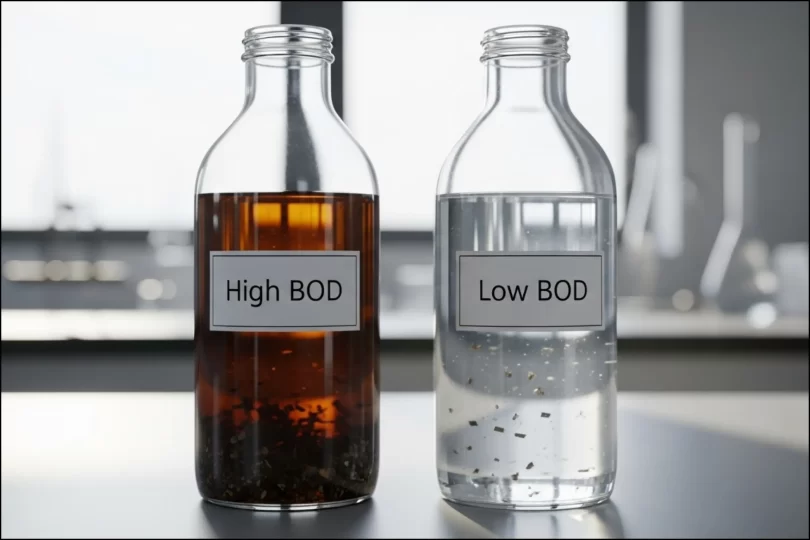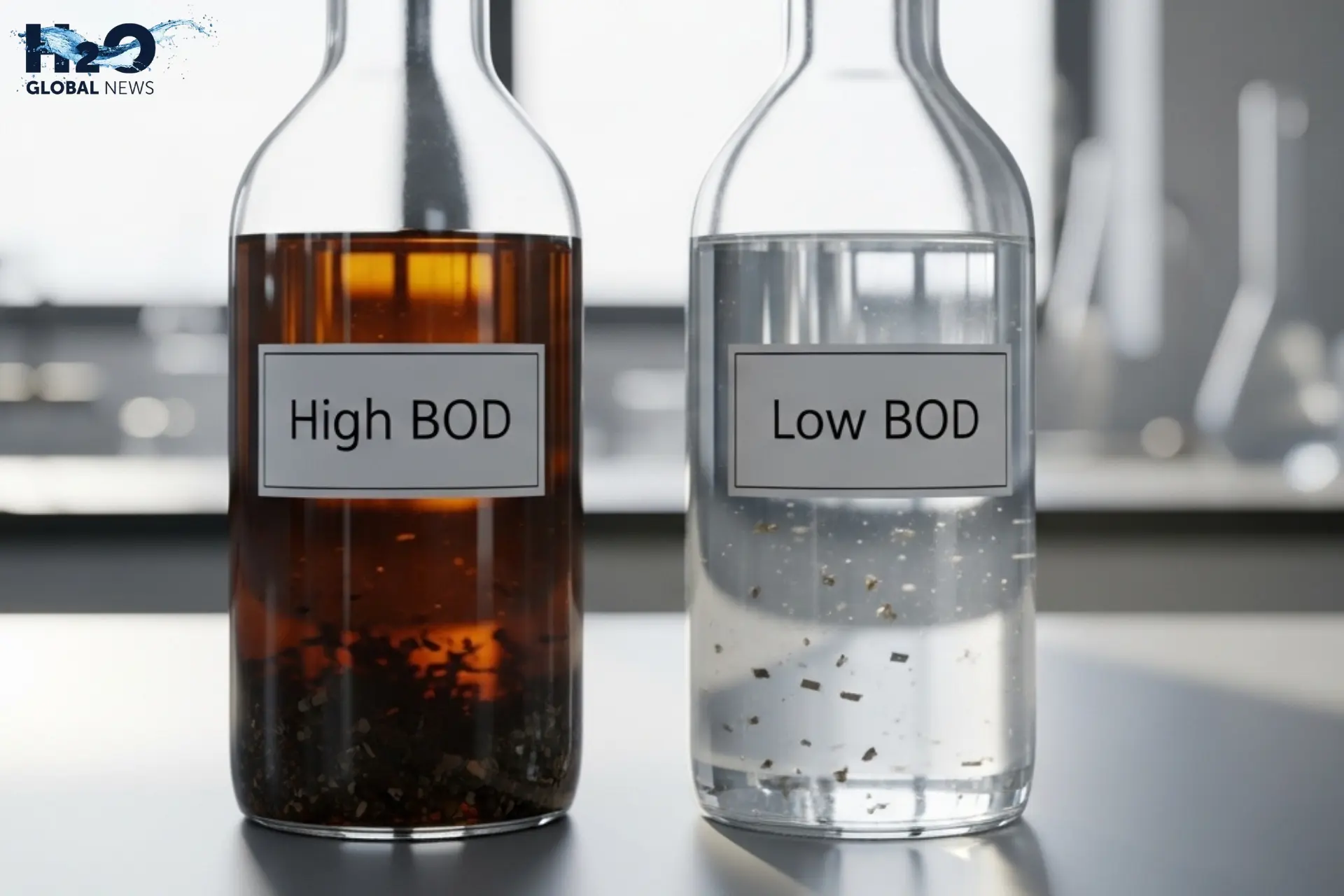Biochemical Oxygen Demand (BOD) is one of the most important parameters for checking BOD in water quality. It shows how much oxygen microorganisms need to break down organic matter in wastewater. A higher BOD means more organic pollution, while a lower BOD points to cleaner water. Because of this, BOD is widely used to monitor wastewater treatment efficiency and to make sure discharged water doesn’t harm rivers, lakes, or aquatic life.
In this article, we’ll look at what BOD of water really means in wastewater, why it matters, and how it is tested.
What Is BOD in Wastewater?
Biochemical Oxygen Demand (BOD) in wastewater is a measure of the amount of oxygen required by microorganisms to break down the organic matter present in it. In other words, it reflects the strength of organic pollution in the water.
- High BOD → more organic waste, more oxygen consumed by microbes, greater risk of oxygen depletion in rivers and lakes.
- Low BOD → cleaner water with less organic matter.
BOD is usually expressed in milligrams of oxygen consumed per liter of water (mg/L) over a set period. The standard test, called BOD₅, measures the oxygen used over five days at 20°C. This gives a reliable estimate of how much pollution a wastewater sample contains and its potential impact on the environment.
In wastewater treatment, BOD is one of the most critical indicators for evaluating how polluted the incoming sewage is and how effective treatment processes are in reducing that pollution before discharge.
Impact of High BOD on the Environment
High BOD in wastewater can lead to oxygen depletion hypoxia water in rivers, lakes, and ponds. As microorganisms consume oxygen rapidly:
- Fish and aquatic organisms may die due to lack of oxygen.
- Aquatic food chains get disrupted.
- Harmful bacteria and algae can multiply, degrading water quality and producing unpleasant odors.
Sources of BOD in Wastewater
BOD wastewater originates from organic matter present in water or wastewater, which serves as food for microorganisms. Common sources include:
- Domestic Wastewater – Human sewage with food residues, proteins, fats, carbohydrates, and detergents.
- Industrial Wastewater – Effluents from food processing, pulp and paper, textile, and dairy industries containing sugars, starches, oils, and chemicals.
- Agricultural Runoff – Animal waste, crop residues, and fertilizers entering rivers and streams.
- Natural Organic Matter – Decaying plants, leaves, and animal remains in water bodies.
- Stormwater Runoff – Rainwater carrying organic debris, oils, and other pollutants from cities and roads.
Factors Affecting BOD
Several factors influence BOD levels:
- Organic Load: More biodegradable waste → higher BOD.
- Temperature: Warm water accelerates microbial activity, increasing oxygen consumption.
- Toxic Substances: Heavy metals or disinfectants can inhibit microbial activity, lowering measured BOD.
- pH and Nutrients: Microbial growth depends on balanced pH and availability of nitrogen and phosphorus.
- Type of Waste: Easily degradable matter (sugars, proteins) raises BOD quickly, while fats and synthetic compounds degrade more slowly.
BOD in Wastewater Treatment Plants
In wastewater treatment plants (WWTPs), BOD is a key parameter for assessing treatment efficiency.
- Incoming sewage typically has a high BOD, indicating significant organic pollution.
- Primary treatment (sedimentation) removes solids but has little impact on BOD.
- Secondary treatment (activated sludge, trickling filters, biofilm reactors) significantly lowers BOD by 85–95%.
- Treated effluent must meet regulatory BOD limits (often below 30 mg/L) before discharge into natural water bodies.
How BOD Is Determined
The standard BOD₅ water test measures oxygen consumption over 5 days at 20°C. The procedure involves:
- Sample Collection: Collect representative wastewater without aeration or contamination.
- Dilution (if needed): Highly polluted samples are diluted with BOD-free water.
- Seeding: If microorganisms are insufficient, seed microbes (e.g., from activated sludge) are added.
- Initial DO Measurement: Measure dissolved oxygen (DO) at the start.
Incubation: Seal the sample in a BOD bottle and incubate at 20°C in the dark for 5 days. - Final DO Measurement: Measure DO again after incubation.
- Calculation: BOD = (Initial DO – Final DO), adjusted for dilution if applied.
How to Reduce BOD in Water
- Proper Wastewater Treatment – Secondary treatment can reduce BOD by up to 95%.
- Industrial Pre-Treatment – Food, dairy, textile, and paper industries should pre-treat effluents.
- Aeration – Adding oxygen helps microbes break down organic matter faster.
- Avoiding Direct Discharge – Preventing raw sewage, agricultural runoff, and industrial waste from entering water bodies.
- Constructed Wetlands/Natural Systems – Plants and microbes naturally reduce organic matter.
- Regular Monitoring – Ensures early detection of pollution and treatment effectiveness.
Conclusion
Biochemical Oxygen Demand (BOD) is a vital indicator of water quality, reflecting the amount of organic pollution in wastewater. High BOD levels signal heavy organic waste that can deplete dissolved oxygen in natural water bodies, harming aquatic life. Low BOD indicates cleaner water.
By monitoring BOD, industries and municipalities can track treatment efficiency and protect rivers, lakes, and aquatic ecosystems. Reducing BOD through proper treatment, aeration, and pollution control is essential for sustainable water management.
FAQs
What is BOD in simple terms?
It’s the amount of oxygen microorganisms need to break down organic matter in water.
Why is BOD important in wastewater management?
It shows how polluted wastewater is and how effective treatment processes are.
How is BOD measured?
By incubating a sample for 5 days at 20°C and comparing oxygen levels before and after.
What are common sources of BOD?
Domestic sewage, industrial effluents, agricultural runoff, stormwater, and natural organic matter.
What is a good BOD level for wastewater?
Treated wastewater should typically have BOD below 30 mg/L before being discharged.
What’s the difference between BOD and COD?
BOD measures biodegradable pollution, while COD measures total (biodegradable + non-biodegradable) pollution.










